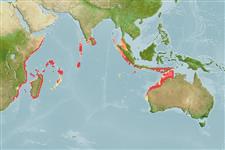Common names from other countries
>
Eupercaria/misc (Various families in series Eupercaria) >
Lethrinidae (Emperors or scavengers) > Lethrininae
Etymology: Lethrinus: Greek, lethrinia, a fish pertaining to genus Pagellus.
More on author: Smith.
Environment: milieu / climate zone / depth range / distribution range
Écologie
marin récifal; non migrateur; profondeur 5 - 150 m (Ref. 4369). Tropical; 10°N - 28°S
Western Indian Ocean: Natal, South Africa to the Seychelles and Sri Lanka, possibly more widespread. Has previously been synonymized with Lethrinus mahsena which is now regarded as a separate species.
Taille / Poids / Âge
Maturity: Lm ? range ? - ? cm
Max length : 60.0 cm TL mâle / non sexé; (Ref. 4369)
Épines dorsales (Total): 10; Rayons mous dorsaux (Total): 9; Épines anales 3; Rayons mous anaux: 8.
Solitarily found in coastal waters trawling grounds and coral reef areas (Ref. 2295, 90102). Marketed fresh (Ref. 171).
Life cycle and mating behavior
Maturité | Reproduction | Frai | Œufs | Fécondité | Larves
Carpenter, K.E. and G.R. Allen, 1989. FAO Species Catalogue. Vol. 9. Emperor fishes and large-eye breams of the world (family Lethrinidae). An annotated and illustrated catalogue of lethrinid species known to date. FAO Fish. Synop. 125(9):118 p. Rome: FAO. (Ref. 2295)
Statut dans la liste rouge de l'IUCN (Ref. 130435)
CITES (Ref. 128078)
Not Evaluated
Menace pour l'homme
Harmless
Utilisations par l'homme
Pêcheries: commercial; pêche sportive: oui
Plus d'informations
PaysZones FAOÉcosystèmesOccurrencesIntroductionsStocksÉcologieRégime alimentaireÉléments du régime alimentaireConsommation alimentaireRation
Noms communsSynonymesMétabolismePrédateursÉcotoxicologieReproductionMaturitéFraiFéconditéŒufsDéveloppement de l'œuf
RéférencesAquacultureProfil d'aquacultureSouchesGénétiqueElectrophoresesHéritabilitéPathologiesTraitementMass conversion
CollaborateursImagesStamps, Coins Misc.SonsCiguateraVitesseType de nageSurface branchialeOtolithesCerveauxVision
Outils
Articles particuliers
Télécharger en XML
Sources Internet
Estimates based on models
Preferred temperature (Ref.
115969): 24.5 - 28.8, mean 27.1 (based on 256 cells).
Phylogenetic diversity index (Ref.
82804): PD
50 = 0.5000 [Uniqueness, from 0.5 = low to 2.0 = high].
Bayesian length-weight: a=0.01514 (0.00706 - 0.03245), b=2.98 (2.81 - 3.15), in cm Total Length, based on LWR estimates for this Genus-body shape (Ref.
93245).
Niveau trophique (Ref.
69278): 3.7 ±0.4 se; based on size and trophs of closest relatives
Résilience (Ref.
120179): Milieu, temps minimum de doublement de population : 1,4 à 4,4 années (Preliminary K or Fecundity.).
Fishing Vulnerability (Ref.
59153): Moderate vulnerability (44 of 100).
